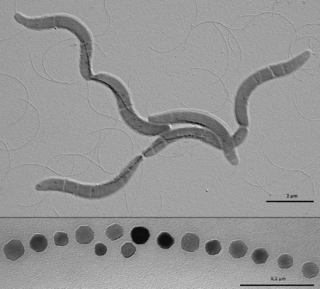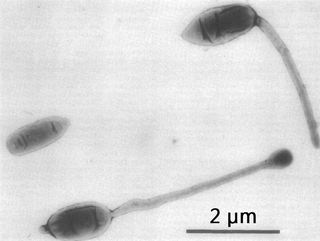
The Rhodospirillales are an order of Pseudomonadota.
The Phyllobacteriaceae are a family of bacteria. The most common genus is Mesorhizobium which contains some of the rhizobia species.
The Aurantimonadaceae are a small family of marine bacteria.

The Hyphomicrobiaceae are a family of bacteria. Among others, they include Rhodomicrobium, a genus of purple bacteria.
The Nitrobacteraceae are a family of gram-negative, aerobic bacteria. They include plant-associated bacteria such as Bradyrhizobium, a genus of rhizobia associated with some legumes. It also contains animal-associated bacteria such as Afipia felis, formerly thought to cause cat-scratch disease. Others are free-living, such as Rhodopseudomonas, a purple bacterium found in marine water and soils. The strain Rhodopseudomonas palustris DX-1 can generate an electric current with no hydrogen production, a trait being explored in the development of the microbial fuel cell. The genus Afipia has also been found in the atmosphere, where it uses methylsulfonylmethane as a carbon source.
Rhodopseudomonas is a genus of bacteria from the family Nitrobacteraceae.
The Sphingomonadales are an order of the Alphaproteobacteria.
Erythrobacteraceae is a bacterium family in the order of Sphingomonadales.
Pleomorphomonas is a genus of bacteria from the order Hyphomicrobiales.
Caenibius tardaugens is an oestradiol-degrading bacterium from the family Hyphomicrobiaceae which has been isolated from activated sludge from a sewage treatment plant in Japan.
Devosiaceae is a family of Alphaproteobacteria.
Stappiaceae is a family of Alphaproteobacteria.
Tepidamorphaceae is a family of Alphaproteobacteria.
Parvibaculaceae is a family of Alphaproteobacteria.
Methylorubrum is a genus of bacteria from the family Methylobacteriaceae.
The Stellaceae are a family of bacteria from the order Rhodospirillales.
Reyranella is a genus of bacteria from the order Rhodospirillales.
The Thalassobaculaceae are a family of bacteria from the order Rhodospirillales.
The Azospirillaceae are a family of bacteria from the order Rhodospirillales.
"Neopararhizobium haloflavum" is a species of bacteria from the family Rhizobiaceae.

